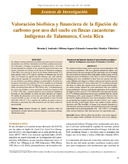Valoración biofísica y financiera de la fijación de carbono por uso del suelo en fincas cacaoteras indígenas de Talamanca, Costa Rica

View/
Date
2008Autor Corporativo
CATIE – Centro Agronómico Tropical de Investigación y Enseñanza
Type
Artículo
Metadata
Show full item recordAlternative title
Biophysical and financial valuation of carbon fixation according to land use in indigenous cacao farms of Talamanca, Costa Rica
Description
1 fotografía, 5 tablas, 19 ref.
Abstract
Se estimó el almacenamiento de carbono de cinco usos de la tierra (cacaotales con árboles, bananales con árboles, plátano monocultivo, charrales y bosques de galería), el margen bruto y el costo de oportunidad de cambiar el uso actual del suelo hacia otros con mayor contenido de carbono en las fincas de Talamanca indígena, Costa Rica. Los usos de la tierra en las lomas almacenaron 22% más carbono total y 47% más de carbono en biomasa que los del valle. Los bosques de galería son los sistemas que más carbono almacenaron, seguidos de cacaotales con árboles, charrales, banano con árboles y, por último, plátano en monocultivo. El suelo fue el mayor reservorio de carbono (27-74%), seguido de la biomasa arriba del suelo (15-57%). El plátano es el uso del suelo más rentable, con un beneficio neto de 798 US$ ha-1 año-1. Las plantaciones de cacao con árboles y arroz presentan beneficios negativos (59 y 14 ha-1 US$ año-1, respectivamente), pero permiten capitalizar la mano de obra familiar en zonas sin otras opciones de empleo. El cambio de platanales a otros usos del suelo para fijar carbono es poco factible, ya que el costo de oportunidad es muy elevado (20,8-50,1 US$ tC-1). Los cambios de cultivos de maíz o arroz a charrales y cacaotales son más atractivos por sus bajos costos de oportunidad. We estimated carbon storage in five land uses (cocoa plantations with trees, banana plantations with trees, plantain plantations, fallows and riparian forests), the gross margin and the opportunity cost of changing the current land use towards others with higher carbon storage rates in indigenous farms of Talamanca, Costa Rica. A total of 199 permanent sampling plots were established in these land use systems and landscapes (hillsides and valleys) to estimate carbon stock. Land use systems in the hillsides stored 22% more carbon and 47% of carbon in biomass than those in valleys. The riparian forest was the system with the highest carbon storage, followed by cocoa plantations with trees, fallows, banana plantations with trees and plantain plantations. Soil constituted the highest carbon pool (27-74%), followed by aboveground biomass (15-57%). Plantain plantations was the more profitable land use system in Talamanca, with a gross margin of U$798 ha-1 year-1; however, they also had the highest production costs. Cacao plantations with trees and rice production had negative benefits (59 and 14 U$ ha-1 year-1, respectively), but they turned family labour into capital at places without alternative jobs. The feasibility of change from plantain plantation to other land use systems to increase carbon fixation is low, due to the high opportunity cost of growing plantains (20.1 - 50.1 US$ t C-1). Changing maize and rice fields into other land uses have low opportunity costs.
Publisher
CATIE, Turrialba (Costa Rica)

